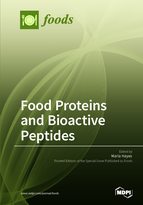Food Proteins and Bioactive Peptides
A special issue of Foods (ISSN 2304-8158). This special issue belongs to the section "Food Physics and (Bio)Chemistry".
Deadline for manuscript submissions: closed (15 December 2017) | Viewed by 211595
Special Issue Editor
Interests: proteins; peptides; bioactives; animal health; functional foods; heart health; diabetes; inflammation; pain; pharma; functional foods
Special Issues, Collections and Topics in MDPI journals
Special Issue Information
Dear Colleagues,
This Special Issue will look at the advances made in the extraction and synthesis of bioactive peptides from different food protein sources, in addition to increased and novel uses of these peptides in functional foods and pharmaceuticals for the prevention of diseases associated with metabolic syndrome including diabetes, heart health, obesity and inflammation.
Dr. Maria Hayes
Guest Editor
Manuscript Submission Information
Manuscripts should be submitted online at www.mdpi.com by registering and logging in to this website. Once you are registered, click here to go to the submission form. Manuscripts can be submitted until the deadline. All submissions that pass pre-check are peer-reviewed. Accepted papers will be published continuously in the journal (as soon as accepted) and will be listed together on the special issue website. Research articles, review articles as well as short communications are invited. For planned papers, a title and short abstract (about 100 words) can be sent to the Editorial Office for announcement on this website.
Submitted manuscripts should not have been published previously, nor be under consideration for publication elsewhere (except conference proceedings papers). All manuscripts are thoroughly refereed through a single-blind peer-review process. A guide for authors and other relevant information for submission of manuscripts is available on the Instructions for Authors page. Foods is an international peer-reviewed open access semimonthly journal published by MDPI.
Please visit the Instructions for Authors page before submitting a manuscript. The Article Processing Charge (APC) for publication in this open access journal is 2900 CHF (Swiss Francs). Submitted papers should be well formatted and use good English. Authors may use MDPI's English editing service prior to publication or during author revisions.
Keywords
- marine-derived peptides,
- dairy peptides,
- in vivo assessment,
- functional foods,
- pharmaceuticals,
- co-products,
- microalgal proteins,
- diabetes,
- metabolic syndrome,
- heart health,
- circular economy,
- biorefinery concepts and the circular economy







